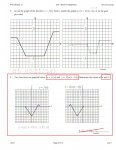In the above question I'm asked to determine the difference between the 2 graphs one being "y=f(x)" the other being "y=f(a(x-b))". I am to find the values of "a and b." The graph has obviously flipped over the Y axis creating a Horizontal Invert but to create this you must have a "-" (negative) attached to the "x" value. Ie: y=f(a(-x-b)). If I attach a "-" (negative) to "a" it would flip the graph over the x axis creating a Vertical Invert. I don't understand how I can answer this question being able to only give the values of "a and b." I know I must be missing something here. please help.
You are using an out of date browser. It may not display this or other websites correctly.
You should upgrade or use an alternative browser.
You should upgrade or use an alternative browser.
Graph Transformation Issue.
- Thread starter Duston
- Start date
Look at a corresponding line for each of the graphs: On the left hand side a line goes through (0, -6) and (4,1) giving line
L1: \(\displaystyle y\, =\, -6\, +\, \frac{7}{4}\, x\)
The corresponding line on the right goes through (-3,-6) and (-7,1) for
L2: \(\displaystyle y\, =\, -6\, -\, \frac{7}{4}\, (x\, +\, 3)\)
What would you have to substitute for x in L1 to get L2? What would you have to substitute for x in L2 to get L1?
L1: \(\displaystyle y\, =\, -6\, +\, \frac{7}{4}\, x\)
The corresponding line on the right goes through (-3,-6) and (-7,1) for
L2: \(\displaystyle y\, =\, -6\, -\, \frac{7}{4}\, (x\, +\, 3)\)
What would you have to substitute for x in L1 to get L2? What would you have to substitute for x in L2 to get L1?
Look at a corresponding line for each of the graphs: On the left hand side a line goes through (0, -6) and (4,1) giving line
L1: \(\displaystyle y\, =\, -6\, +\, \frac{7}{4}\, x\)
The corresponding line on the right goes through (-3,-6) and (-7,1) for
L2: \(\displaystyle y\, =\, -6\, -\, \frac{7}{4}\, (x\, +\, 3)\)
What would you have to substitute for x in L1 to get L2? What would you have to substitute for x in L2 to get L1?
I think I know what you're saying, but for this question I'm not suppose to be solving for X I'm only asked to determine the values of "a and b" within the given function. I'm learning transformations and transitions/reflections etc. (pretty new at this)
I am suppose to explain how Graph 1 has been transformed into Graph 2 by only selecting values for "a and b"
My issue is that I don't see how it's possible for Graph 1 to transform into Graph 2 without manipulating the "x" into a "-x." Given I'm not suppose to do that I'm uncertain how to answer this question.
Look at L1 and call it f(x),I think I know what you're saying, but for this question I'm not suppose to be solving for X I'm only asked to determine the values of "a and b" within the given function. I'm learning transformations and transitions/reflections etc. (pretty new at this)
I am suppose to explain how Graph 1 has been transformed into Graph 2 by only selecting values for "a and b"
My issue is that I don't see how it's possible for Graph 1 to transform into Graph 2 without manipulating the "x" into a "-x." Given I'm not suppose to do that I'm uncertain how to answer this question.
f(x) = \(\displaystyle -6\, +\, \frac{7}{4}\, x\)
Now
f(a(x-b)) = \(\displaystyle -6\, +\, \frac{7}{4}\, a(x-b)\, = -6\, - \frac{7}{4} a\, b\, +\, a\, \frac{7}{4}\, x\)
for that to look like L2
L2: \(\displaystyle -6\, -\, \frac{7}{4}\, (x+3)\, = -6\, -\, 3\, *\, \frac{7}{4}\, -\, \frac{7}{4}\, x\)
what must the value of a and b be? So first translate the graph ? units right/left/up/down, then reflect/mirror/rotate/stretch/shrink the graph about the x/y axis or whatever.
Last edited:

